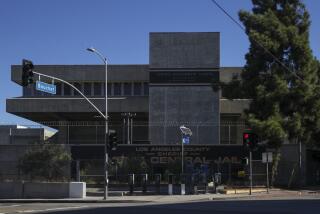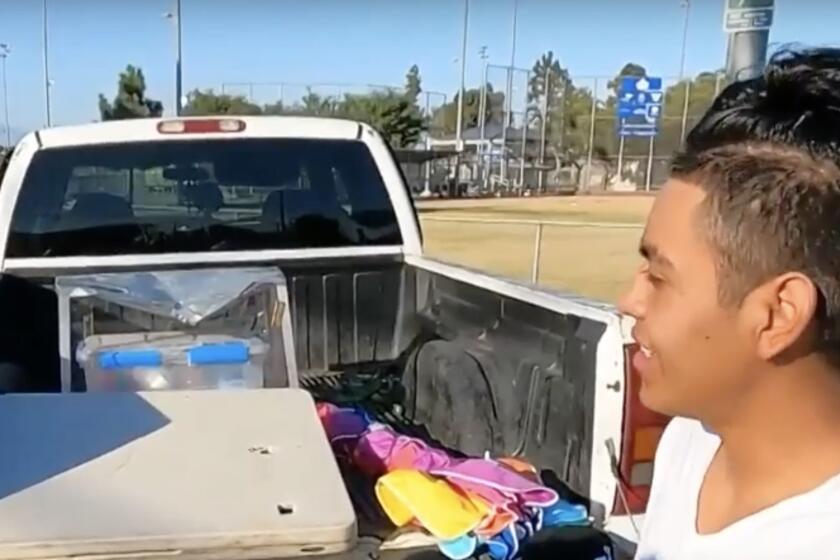Bold Talk on Quake Safety, Little Action
Times coverage and resources
In the nine months since Hurricane Katrina renewed worries about California’s preparedness for a major earthquake, Gov. Arnold Schwarzenegger has talked passionately about seismic safety.
The governor has demanded federal assistance to shore up the state’s sagging levees — which he says are “an earthquake away” from disaster — and urged retrofitting of schools and hospitals.
But behind the scenes, Schwarzenegger has made several moves that many seismic safety advocates say would weaken the state’s ability to deal with a major temblor.
They cite the governor’s support for efforts to reduce seismic safety rules at community colleges, as well as his veto of the funding for the independent panel that reviews state seismic policy and advocates for earthquake safety.
The governor’s office rejects the criticism, saying Schwarzenegger and his wife, Maria Shriver, are using their bully pulpit to raise awareness about earthquake safety while also trying to balance quake regulations with the costs that such rules would place on private industry and government agencies.
The latest clash involves the $37-billion infrastructure bond package backed by Schwarzenegger that has been placed on the November ballot.
The bond measure sets aside $200 million for seismic retrofitting of public schools. But that is half of what seismic safety experts sought and only a fraction of the $5 billion that the state estimated the total bill might cost. The governor’s office argued in negotiations that $200 million was sufficient for now.
The measure also includes a provision added with the governor’s support that exempts community colleges from the tough building and inspection standards of the state’s Field Act, meant to safeguard students in public schools from earthquake hazards. If voters approve the bond measure, community colleges would not have to abide by the strictest earthquake construction and inspection standards when building new facilities or buying existing structures.
Schwarzenegger’s nuanced stance on seismic safety was visible last month when he addressed hundreds of scientists and emergency preparedness officials marking the 100th anniversary of the 1906 San Francisco earthquake.
He called for the creation of a new state Department of Public Health to help with emergency response. “We also must find a way to retrofit our schools and our public hospitals to make sure that they are seismically safe because it is way overdue,” the governor told the crowd.
But just months earlier, the governor had vetoed funding for the Seismic Safety Commission, the panel of scientists and safety experts that is the state’s independent earthquake policy body.
Long a thorn in the side of developers and government agencies for its calls for greater quake safety rules, the panel had twice beaten back earlier efforts to exempt community colleges from seismic standards.
The panel also has become a target of the insurance industry because the commission is financed by a fee on California policyholders.
The insurance industry has donated about $3.6 million to Schwarzenegger campaign funds, and one of its chief former lobbyists now serves as the governor’s chief policy advisor.
The governor initially considered killing the commission, saying its work could be done by state employees. Now he wants the commission subsumed by the State and Consumer Services Agency, a move he says would be more efficient and bring it closer to his office. Some commissioners, however, say the change would rob the panel of its independence by placing it under the control of an appointee of the governor.
Despite the governor’s bold talk about earthquake safety, some seismic safety experts question whether he is committed to following through, especially when it means going against interests that have long fought greater seismic regulations.
“He’s taking steps, but he’s not doing it in a comprehensive way,” said Mary Lou Zoback, scientist-in-charge for the U.S. Geological Survey in Northern California.
Geological Survey seismologist Lucy Jones, a Schwarzenegger appointee to the Seismic Safety Commission who was fired and then rehired last month, was more pessimistic.
“I don’t think it’s a focus of this administration,” she said. “He’s not actively doing much of anything.”
The governor’s office points to more than a dozen speeches and executive orders aimed at shoring up seismic safety, including his aggressive push for federal aid to repair the levees.
Schwarzenegger has secured more than $1 billion in federal funds for homeland security and public health, aides say, adding that this money also will enhance earthquake response. He also has signed legislation that allows cities to impose seismic standards on quake-vulnerable apartment buildings and parking garages, and ordered the creation of a high-level working group to study the state’s preparedness needs.
First Lady Maria Shriver has campaigned to persuade Californians to better prepare for quakes by setting up earthquake kits and taking other precautions at home.
But critics say that little concrete action has been taken to protect the state.
For example, Schwarzenegger has repeatedly said in speeches that hospitals should be retrofitted to conform with earthquake safety standards. But he did not include funds for retrofitting hospitals in his original outline for the bond, and Democrats in the Legislature, who had pushed to include the funds, gave up trying to include them last month.
Schwarzenegger has not taken a stand on the debate in Sacramento over whether hospitals should be given extra time to comply with state law requiring them to retrofit. Under current law, which already has been amended to allow certain extensions, some hospitals must retrofit to meet basic life-safety standards by 2008 and others by 2013. Spokeswoman Sabrina Lockhart said Monday that the administration did not have a specific plan for retrofitting public hospitals.
The administration has clashed with seismologists and safety experts over exempting community colleges from the strict quake inspection and building codes that govern elementary schools and high schools.
The governor, along with some in the Legislature, argue that the rules are too stringent and make it too expensive for community colleges to build new facilities.
Henry Renteria, the governor’s director of the Office of Emergency Services, acknowledges some gaps in the system — particularly with regard to planning regionwide responses to huge events. But Renteria said California is better prepared than any other state for man-made or natural disasters.
He said much of the credit goes to Schwarzenegger, who has pressed both his agency and local communities to improve their disaster preparedness planning.
But a new report by the Little Hoover Commission, a state watchdog agency, suggests California still has a long way to go.
“California is as vulnerable as Louisiana, and perhaps equally unprepared for a catastrophic event,” the commission states in a report released earlier this month.
Stanley Zax, the commission’s vice chairman, said he is particularly concerned about the state’s decentralized process for responding to disasters, and the lack of specific evacuation plans for large areas.
What would happen, he asked, if the only way out of Los Angeles or San Bernardino was to drive into the desert?
“If we had it in the summertime and there’s no gas stations out in the desert and everybody’s parked there in the summer heat in Death Valley, what’s our plan?” Zax asked. “I think we need a plan.”
More to Read
Sign up for Essential California
The most important California stories and recommendations in your inbox every morning.
You may occasionally receive promotional content from the Los Angeles Times.










